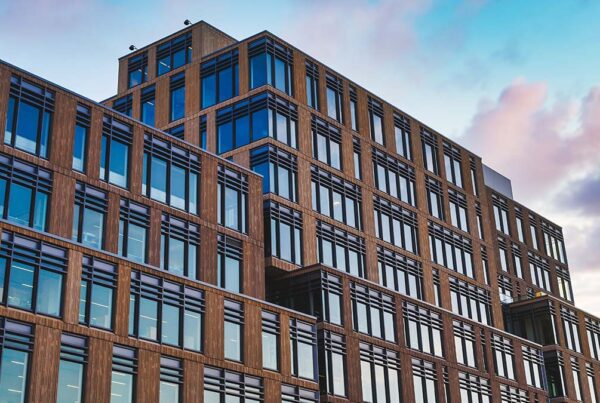
Commercial office real estate is any building that consists of offices for businesses.
Like multifamily real estate, investors often find commercial office real estate appealing due to the multi-tenant component.
Multi-tenant means more than one tenant occupies the building. Multi-tenant buildings reduce risk because if one tenant leaves, other tenants will still cover most of your bills.
Commercial office space is grouped into three categories: building type, office type, and building class.
What Are the Different Types of Commercial Office Buildings?
Central Business District (CBD)
Large developed cities like Chicago, London, and Paris, typically have a central business district (CBD) in the city’s heart.
Office buildings in a central business district house many of the region’s largest companies. These companies often want the prestige and practicality of being located in a large, well-known city. By establishing a corporate office in a central business district, large companies are easily accessed both nationally and internationally. The city and suburbs surrounding central business districts allow the company to employ thousands of people with ample housing nearby.
Central business districts are designed to be high-density, so these office buildings are mid-rise and high-rise buildings with elevator access. Some are even mixed-use real estate with retail real estate on the ground level and office space above.
Suburban Office Buildings
Suburban office buildings are built in the suburbs of a city and are typically low- or mid-rise buildings.
Sometimes suburban office buildings are grouped into an office park for several different companies or a campus for a single company. Office parks and office campuses tend to be designed similarly to Garden Apartments in that they contain a significant amount of landscaping and green space in between buildings.
Companies may choose to select a suburban office building over a location in the central business district if it is more affordable, easier for their employees to access, more central to the area they serve, or don’t want to deal with downtown congestion.
Commercially Zoned Homes
Commercially zoned homes are former residential properties that have been rezoned for commercial use.
Small businesses and firms such as law firms, tax firms, and accounting firms often prefer these types of office buildings because they provide enough space for a handful of offices and include nice amenities such as full kitchens, ample parking, patios, and back yards.
Since commercially zoned homes are standalone buildings, tenants won’t feel like they’re stacked on top of other businesses and don’t need to worry about other tenant behavior.
Medical Offices
Medical office space is office spaced designed to meet the needs of healthcare providers.
Medical offices range drastically in size because they support all healthcare services, from dentists, physical therapists, dermatologists, and audiologists to large operation centers and hospitals.
Due to the unique needs of healthcare services such as larger elevators, higher HVAC standards, additional plumbing, space to house specialized equipment, medical tenants tend to spend more money on their build-outs, have longer leases, and don’t move around much.
What Are the Different Types of Office Spaces?
The five types of office spaces include traditional office space, creative office space, contiguous office space, coworking office space, and shared office space.
Here’s an overview of each type.
Traditional Office Space
Traditional office spaces are designed to provide employees with quiet, private offices or areas to work so that they can support one-on-one clients and confidential information.
Standard features of traditional office space include a reception area, C-Suite offices, private offices, and more open areas where junior employees are grouped in cubicles or a shared working environment.
Creative Office Space
Creative office space is office space designed to emphasize collaboration by reducing physical barriers and promoting transparency, communication, and collaboration amongst all teams and levels of employees.
Creative office spaces provide an efficient way to fit more employees per square foot and are favorites for startups, tech companies, and creative agencies.
Contiguous Office Space
Contiguous office space contains multiple suites or areas of a building that are combined and rented to a single tenant in a “contiguous” space.
This means that a single tenant can rent multiple suites on the same floor of a building in a continuous office space (e.g., suites 15–21), or a single tenant can rent three floors of office space in a contiguous space (e.g., floors 12–16).
Contiguous office space is excellent for businesses who want to organize their offices by department but want to keep the whole company in the same building.
Coworking Space
Coworking office space is office space shared by a high number of individuals and small businesses. Coworking office space typically includes a reception area, kitchen area, individual desks, meeting rooms, and private offices.
Compared to other types of office space, coworking office space is highly flexible. Depending on the provider, coworking space can often be rented on a daily, monthly, or yearly terms.
The smaller size, lower cost, and flexible renting terms make coworking office space an excellent option for sole proprietors and small businesses.
Shared Office Space
Shared office space is an arrangement in which a company with extra office space leases a portion of it to another company.
The shared office space setup is a win-win situation because it enables the primary tenant to cover some of their office costs while providing the secondary tenant with an affordable option for the office space they need.
What Are the Different Classes of Office Buildings?
Commercial office real estate is categorized into three different classes of office buildings, including Class A, B, and C, depending on their age and quality.
What is Class A Office Space?
Class A office space is the highest-quality, top-tier office space. Class A office space characteristics include a strong market presence, excellent finishes, modern amenities, and prime location. Successful tenants typically pay above-average rents for Class A office space.
What is Class B Office Space?
Class B office space is the second tier of office space. Class B office space characteristics include a quality building, nice finishes, modern amenities, and a good location. Class B office space is effectively Class A office space, without the extra features, high-end finishes, or prime location.
What is Class C Office Space?
Class C office space is the third tier of office space and usually needs updates or repairs. The space is often functional but “bare-bones” because it doesn’t boast amenities, lavish finishes, or prime location. Class C office real estate is typically used for businesses that want to fix them up into nicer offices for a lower price or companies that aren’t customer-facing and don’t feel the need to spend money on all of the bells and whistles.
Commercial Office Real Estate 101
Office real estate is one of many different types of real estate. Here’s an overview of commercial office real estate:
- Commercial office real estate is any building that consists of offices for businesses.
- Investors often find commercial office real estate appealing due to having multi-tenants. However, it is possible to provide single-tenant office leases.
- Commercial office space can be grouped into three different categories:
- 1) Building Type
- Central Business District (CBD)
- Suburban Office Buildings
- Commercially Zoned Homes
- Medical Offices
- 2) Office Type
- Traditional
- Creative
- Contiguous
- Coworking
- Shared
- 3) Building Class
- Class A
- Class B
- Class C
- 1) Building Type



